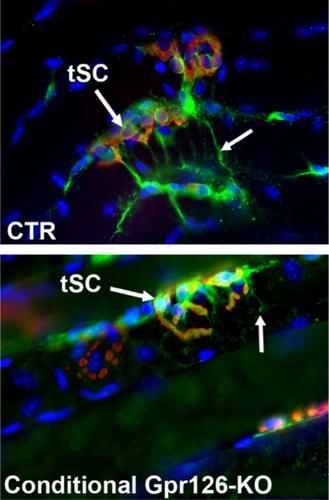Our official English website, www.x-mol.net, welcomes your feedback! (Note: you will need to create a separate account there.)
Gpr126/Adgrg6 contributes to the terminal Schwann cell response at the neuromuscular junction following peripheral nerve injury.
Glia ( IF 6.2 ) Pub Date : 2019-12-24 , DOI: 10.1002/glia.23769 Albina Jablonka-Shariff,Chuieng-Yi Lu,Katherine Campbell,Kelly R Monk,Alison K Snyder-Warwick
Glia ( IF 6.2 ) Pub Date : 2019-12-24 , DOI: 10.1002/glia.23769 Albina Jablonka-Shariff,Chuieng-Yi Lu,Katherine Campbell,Kelly R Monk,Alison K Snyder-Warwick

|
Gpr126/Adgrg6 is an adhesion G protein-coupled receptor essential for Schwann cell (SC) myelination with important contributions to repair after nerve crush injury. Despite critical functions in myelinating SCs, the role of Gpr126 within nonmyelinating terminal Schwann cells (tSCs) at the neuromuscular junction (NMJ), is not known. tSCs have important functions in synaptic maintenance and reinnervation, and after injury tSCs extend cytoplasmic processes to guide regenerating axons to the denervated NMJ. In this study, we show that Gpr126 is expressed in tSCs, and that absence of Gpr126 in SCs (SC-specific Gpr126 knockout, cGpr126) results in a NMJ maintenance defect in the hindlimbs of aged mice, but not in young adult mice. After nerve transection and repair, cGpr126 mice display delayed NMJ reinnervation, altered tSC morphology with decreased S100β expression, and reduced tSC cytoplasmic process extensions. The immune response promoting reinnervation at the NMJ following nerve injury is also altered with decreased macrophage infiltration, Tnfα, and anomalous cytokine expression compared to NMJs of control mice. In addition, Vegfa expression is decreased in muscle, suggesting that cGpr126 non-cell autonomously modulates angiogenesis after nerve injury. In sum, cGpr126 mice demonstrated delayed NMJ reinnervation and decreased muscle mass following nerve transection and repair compared to control littermates. The integral function of Gpr126 in tSCs at the NMJ provides the framework for new therapeutic targets for neuromuscular disease.
中文翻译:

Gpr126/Adgrg6 有助于周围神经损伤后神经肌肉接头处的终末雪旺细胞反应。
Gpr126/Adgrg6 是一种黏附 G 蛋白偶联受体,对雪旺细胞 (SC) 髓鞘形成至关重要,对神经挤压伤后的修复有重要贡献。尽管在髓鞘化 SCs 中具有关键功能,但 Gpr126 在神经肌肉接头 (NMJ) 的非髓鞘化终末雪旺细胞 (tSCs) 中的作用尚不清楚。tSCs 在突触维持和神经再支配中具有重要功能,损伤后 tSCs 扩展细胞质过程以引导再生的轴突到达去神经支配的 NMJ。在这项研究中,我们表明 Gpr126 在 tSCs 中表达,并且 SCs 中 Gpr126 的缺失(SC 特异性 Gpr126 敲除,cGpr126)导致老年小鼠后肢的 NMJ 维持缺陷,但在年轻的成年小鼠中不会。神经横断和修复后,cGpr126 小鼠显示延迟的 NMJ 神经支配,改变 tSC 形态,降低 S100β 表达,减少 tSC 细胞质过程延伸。与对照小鼠的 NMJ 相比,促进神经损伤后 NMJ 神经再支配的免疫反应也随着巨噬细胞浸润、Tnfα 和异常细胞因子表达的减少而改变。此外,肌肉中的 Vegfa 表达降低,表明 cGpr126 非细胞在神经损伤后自主调节血管生成。总之,与对照同窝仔鼠相比,cGpr126 小鼠在神经横断和修复后表现出延迟的 NMJ 神经支配和肌肉质量减少。Gpr126 在 NMJ 的 tSC 中的整体功能为神经肌肉疾病的新治疗靶点提供了框架。与对照小鼠的 NMJ 相比,促进神经损伤后 NMJ 神经再支配的免疫反应也随着巨噬细胞浸润、Tnfα 和异常细胞因子表达的减少而改变。此外,肌肉中的 Vegfa 表达降低,表明 cGpr126 非细胞在神经损伤后自主调节血管生成。总之,与对照同窝仔鼠相比,cGpr126 小鼠在神经横断和修复后表现出延迟的 NMJ 神经支配和肌肉质量减少。Gpr126 在 NMJ 的 tSC 中的整体功能为神经肌肉疾病的新治疗靶点提供了框架。与对照小鼠的 NMJ 相比,促进神经损伤后 NMJ 神经再支配的免疫反应也随着巨噬细胞浸润、Tnfα 和异常细胞因子表达的减少而改变。此外,肌肉中的 Vegfa 表达降低,表明 cGpr126 非细胞在神经损伤后自主调节血管生成。总之,与对照同窝仔鼠相比,cGpr126 小鼠在神经横断和修复后表现出延迟的 NMJ 神经支配和肌肉质量减少。Gpr126 在 NMJ 的 tSC 中的整体功能为神经肌肉疾病的新治疗靶点提供了框架。表明 cGpr126 非细胞在神经损伤后自主调节血管生成。总之,与对照同窝仔鼠相比,cGpr126 小鼠在神经横断和修复后表现出延迟的 NMJ 神经支配和肌肉质量减少。Gpr126 在 NMJ 的 tSC 中的整体功能为神经肌肉疾病的新治疗靶点提供了框架。表明 cGpr126 非细胞在神经损伤后自主调节血管生成。总之,与对照同窝仔鼠相比,cGpr126 小鼠在神经横断和修复后表现出延迟的 NMJ 神经支配和肌肉质量减少。Gpr126 在 NMJ 的 tSC 中的整体功能为神经肌肉疾病的新治疗靶点提供了框架。
更新日期:2019-12-24
中文翻译:

Gpr126/Adgrg6 有助于周围神经损伤后神经肌肉接头处的终末雪旺细胞反应。
Gpr126/Adgrg6 是一种黏附 G 蛋白偶联受体,对雪旺细胞 (SC) 髓鞘形成至关重要,对神经挤压伤后的修复有重要贡献。尽管在髓鞘化 SCs 中具有关键功能,但 Gpr126 在神经肌肉接头 (NMJ) 的非髓鞘化终末雪旺细胞 (tSCs) 中的作用尚不清楚。tSCs 在突触维持和神经再支配中具有重要功能,损伤后 tSCs 扩展细胞质过程以引导再生的轴突到达去神经支配的 NMJ。在这项研究中,我们表明 Gpr126 在 tSCs 中表达,并且 SCs 中 Gpr126 的缺失(SC 特异性 Gpr126 敲除,cGpr126)导致老年小鼠后肢的 NMJ 维持缺陷,但在年轻的成年小鼠中不会。神经横断和修复后,cGpr126 小鼠显示延迟的 NMJ 神经支配,改变 tSC 形态,降低 S100β 表达,减少 tSC 细胞质过程延伸。与对照小鼠的 NMJ 相比,促进神经损伤后 NMJ 神经再支配的免疫反应也随着巨噬细胞浸润、Tnfα 和异常细胞因子表达的减少而改变。此外,肌肉中的 Vegfa 表达降低,表明 cGpr126 非细胞在神经损伤后自主调节血管生成。总之,与对照同窝仔鼠相比,cGpr126 小鼠在神经横断和修复后表现出延迟的 NMJ 神经支配和肌肉质量减少。Gpr126 在 NMJ 的 tSC 中的整体功能为神经肌肉疾病的新治疗靶点提供了框架。与对照小鼠的 NMJ 相比,促进神经损伤后 NMJ 神经再支配的免疫反应也随着巨噬细胞浸润、Tnfα 和异常细胞因子表达的减少而改变。此外,肌肉中的 Vegfa 表达降低,表明 cGpr126 非细胞在神经损伤后自主调节血管生成。总之,与对照同窝仔鼠相比,cGpr126 小鼠在神经横断和修复后表现出延迟的 NMJ 神经支配和肌肉质量减少。Gpr126 在 NMJ 的 tSC 中的整体功能为神经肌肉疾病的新治疗靶点提供了框架。与对照小鼠的 NMJ 相比,促进神经损伤后 NMJ 神经再支配的免疫反应也随着巨噬细胞浸润、Tnfα 和异常细胞因子表达的减少而改变。此外,肌肉中的 Vegfa 表达降低,表明 cGpr126 非细胞在神经损伤后自主调节血管生成。总之,与对照同窝仔鼠相比,cGpr126 小鼠在神经横断和修复后表现出延迟的 NMJ 神经支配和肌肉质量减少。Gpr126 在 NMJ 的 tSC 中的整体功能为神经肌肉疾病的新治疗靶点提供了框架。表明 cGpr126 非细胞在神经损伤后自主调节血管生成。总之,与对照同窝仔鼠相比,cGpr126 小鼠在神经横断和修复后表现出延迟的 NMJ 神经支配和肌肉质量减少。Gpr126 在 NMJ 的 tSC 中的整体功能为神经肌肉疾病的新治疗靶点提供了框架。表明 cGpr126 非细胞在神经损伤后自主调节血管生成。总之,与对照同窝仔鼠相比,cGpr126 小鼠在神经横断和修复后表现出延迟的 NMJ 神经支配和肌肉质量减少。Gpr126 在 NMJ 的 tSC 中的整体功能为神经肌肉疾病的新治疗靶点提供了框架。



























 京公网安备 11010802027423号
京公网安备 11010802027423号